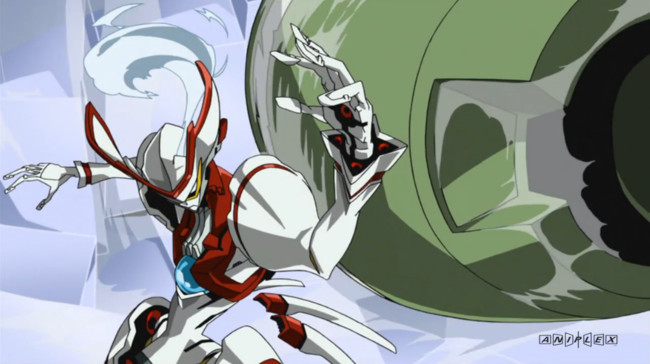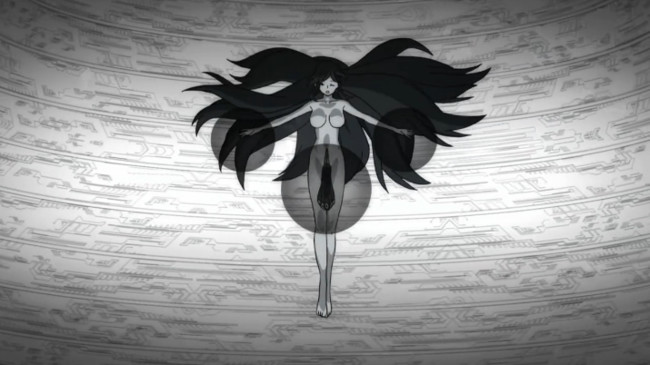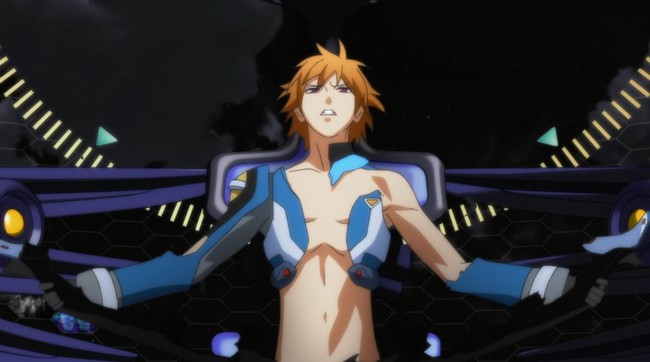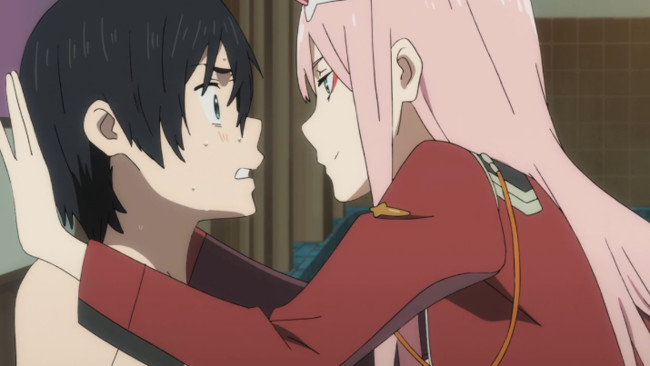When Mechs Equals Sex
by Nicholas Dupree,This season, A-1 Pictures and Studio Trigger's DARLING in the FRANXX has made a big splash with audiences, and it's easy to see why. Not only is it one of the few non-franchise mecha shows we've gotten in recent years, it sports a long list of talented creators bringing to life all the action and angst fans expect from a show about teenagers fighting monsters in giant robots.
It's also very, very horny.

But Darling is far from the first giant robot anime to combine mechanical spectacle with sexual subtext. There's a rich history of anime creators infusing cool robots with puberty metaphors, and one of the most defining titles in FranXX's lengthy lineage is the one it wears most proudly on its sleeve. I'm talking of course about Neon Genesis Evangelion, the show that in many ways defined Studio Gainax, where so many of FranXX's creators cut their teeth.

Evangelion certainly wasn't the first robot anime about a young boy coming of age, but it was perhaps the most direct and emotionally raw for its time. By its final episodes, EVA reaches a laser focus on all of protagonist Shinji's personal insecurities, and understandably, many of those revolve around his sexuality. Where Gundam or Macross protagonists had to grow up by learning responsibility, Shinji's journey to adulthood is about coming to terms with all his worst fears, messy impulses, and trying to unravel the knot of emotions he feels for the women (and a certain angel) in his life – all playing out through the metaphor of fighting aliens in a giant quasi-sentient robot.
I don't need to tell you that Evangelion struck a chord. Its influence permeates nearly every piece of modern anime in some form or another, and its combination of life-or-death fights and psychosexual angst is no exception. However, those themes have taken drastically different forms over the decades since then, and much of FranXX's DNA carries the genes of other, far more jovial works as well.

There are plenty of places to start tracking FranXX's heritage, but where better than the series that made Hiroyuki Imaishi a household name? Studio Gainax's love letter to all things super robot is a far cry from Evangelion in tone, but it's still the story of a young boy trying to figure himself out through giant robot battles at its heart. Simon's journey isn't explicitly about sexual maturation – Lagann on the whole is more focused on summoning everyone's inner badass than addressing the anxieties of sexual awakening – but there's plenty of subtext to be had in the delivery. Our hero's journey transforms him from a timid kid who gets nervous even talking to girls into a stalwart hero fighting alongside his beloved, all while his drill gets bigger and bigger with every battle.
But in the end, on-the-nose visual metaphors are just peashooters in the Innuendo Arms Race. Any anime can throw some Freudian theory into its designs and say it has subtext, but to really up your game, you need to weave it into your story like one of Gurren Lagann's contemporaries.

Eureka Seven is a decidedly more subdued robot show compared to Gainax's rowdy affair, but it wears its themes even more on its sleeve, if that's possible. Much like FranXX, this show uses the concept of copilots to explore the conflicts of building and maintaining a relationship, as our starcrossed teenage lovebirds move from infatuation to a real relationship to essentially parenthood. This actually happens on a couple of different layers – first with protagonist Renton's initially strained relationship with his crush's adopted children, and then again on a grander scale with the show's signature mech, Nirvash.
As a pseudo-sentient mech with two driver's seats, Nirvash acts as a handy metaphor for Renton and Eureka's relationship, as well as a sort of surrogate child for them to take care of, with its own moodswings and preferences. It's a pretty handy measuring stick for communicating the main couple's status in any given moment of the story, but it's also a good way of illuminating both parties' mental states. While either one can pilot on their own, they're far better as a team, and that allows Eureka Seven to do something unique among its Sex Mechs peers by giving equal time to both characters, allowing Eureka to have her own doubts and epiphanies separate or alongside Renton. While far from perfect, it stands out in a sub-genre that's almost totally dominated by male perspectives.
It's also still kinda subtle when you get down to it. Sure, it wears its romance metaphors loud and proud, but at the end of the day, it's still packaged inside a pretty standard coming-of-age story. To really start stressing the boundaries of what constitutes a metaphor, we have to look to a different Studio BONES series.

Screenwriter Yoji Enokido is no stranger to metaphorical puberty stories, with writing credits on Revolutionary Girl Utena, FLCL, RahXephon, and even the Rebuild of Evangelion movies. But in 2010, he teamed up with director Takuya Igarashi to throw subtext to the wind and make a show that was blatantly and literally about being a horny teenager. While Star Driver does sport a complicated sci-fi plot, it's largely all about blatant, ridiculous, beautifully animated innuendo. The magic energy that fuels the series' robots is actually just called Libido, because why not? The central conflict involves defending the seals placed on a quartet of shrine maidens in a virginity metaphor with a veil so thin you can breathe through it. Besides that, the series features a love dodecahedron with all number of excitable teenagers working out their feelings in giant glittery robot battles of the week. Throw on a heaping helping of daddy issues, and you've got yourself a much campier version of FranXX's central themes.

Star Driver turned out to be a setup so nice, they used it twice, with the creative team regrouping in 2014 to make Captain Earth, which was mostly the same show but way more convoluted, and also some of the robots have boobs now. Along with recycling Star Driver's magic Libido energy, the series adds Livlasters, magic guns used to control the series' robots that are also basically meant to be genitalia. But just making the sexual imagery more explicit doesn't do much to make the themes any clearer or the story feel like less of a retread. Captain Earth also loses points for muddling its imagery with a story that mostly builds up to killing a JRPG boss, who had no connection to the sexually charged nomenclature or the vague self-actualization themes that dominated most of the show's run.
Regardless of quality, both shows still ultimately keep a teeny bit of distance from their metaphors. Sure, the robots are powered by Libido, but that's still just an allegory. What if we just made piloting the robots flat-out sexual? Obviously such a daring and unexplored new frontier (Godannar doesn't count) could only be handled by one of the most influential names in anime

Shōji Kawamori is easily one of the most idiosyncratic creators in anime, and aside from Earth Maiden Arjuna, his weirdest legacy is probably the Aquarion franchise. Other series might have made their central conceit sexually charged or plastered fanservice onto their coming-of-age narratives, but only Aquarion makes the universe itself bend to the whims of its horny, desperate teenagers. The titular mechs are actually formed from three separate transforming planes, called Vectors, that combine when the pilots are in-sync enough to touch souls. And it just so happens that touching souls involves being naked and glowing and having an orgasm.

But even that is just the starting point. Aquarion's story is one of love and lust spanning thousands of years, multiple lifetimes, and even separate dimensions, combined with a large enough ensemble cast to make every possible configuration of love polygon in the universe, with the traditional couplings coming in threesomes instead just for that extra spice. The second series, Aquarion Evol, doubles down on all this by building its central philosophy around the imagery of donuts and bananas (which I hope I don't need to explain), not to mention a protagonist who splits himself in two just so he can be in a love triangle with himself. There's even a climactic battle where the heroes win by stripping in their cockpits, because of course there is.

In many ways, FranXX is EVOL's equal and opposite. Both are as blatant as can be with their central metaphors and dripping with innuendo, but FranXX takes a decidedly more sober tone with its imagery. Instead of infectious camp, FranXX's creators have made a return to Evangelion's ponderous psychosexual anxieties, seemingly constructing their entire setting to facilitate that feeling. Even a third of the way through, it's hard to see where it plans to go with all of this, but considering the people involved and the history it has to pull from, just about anything is possible. We're certainly overdue for a series exploring female sexual awakening with giant robot fights, and there's a whole world of queer sexuality you could fill with bombastic explosions too. Regardless of what the future holds, two things will always be certain: anime will always have giant robots, and it will always, always be horny.

So what are your favorite (and least favorite) examples of horny metaphors in giant robot anime? Share your thoughts with us in the forums!
discuss this in the forum (34 posts) |